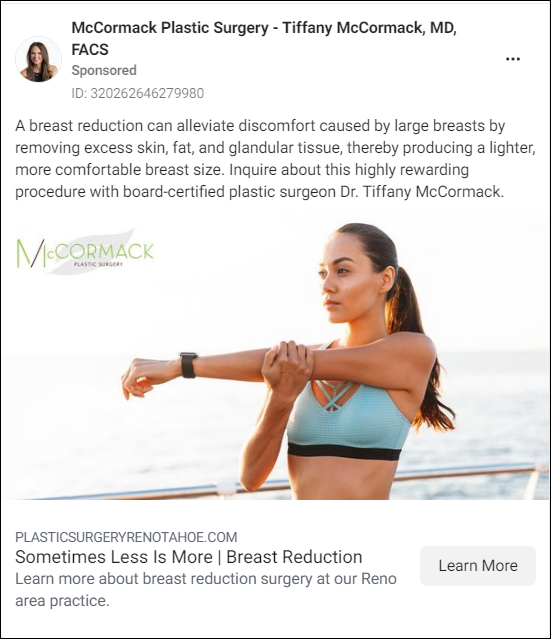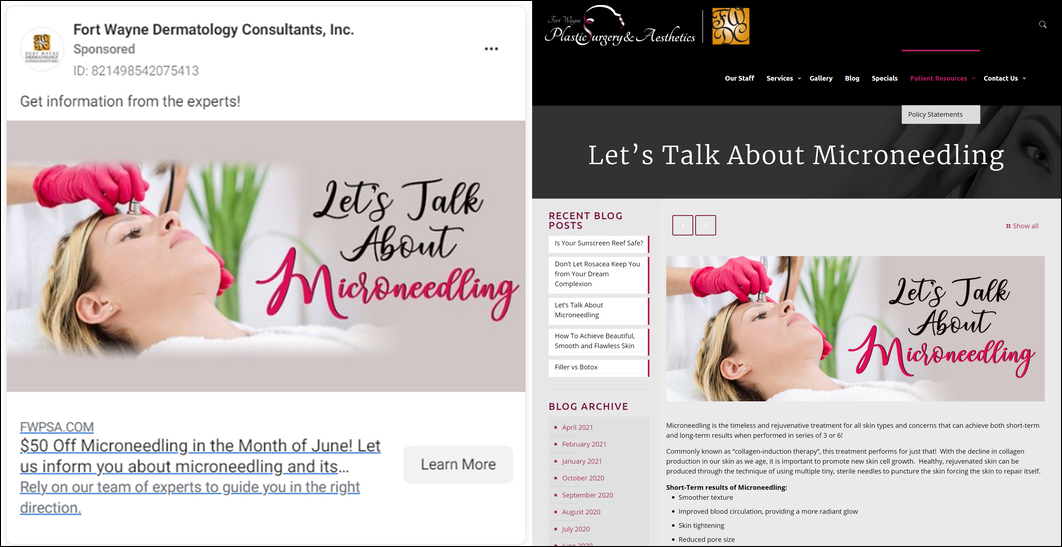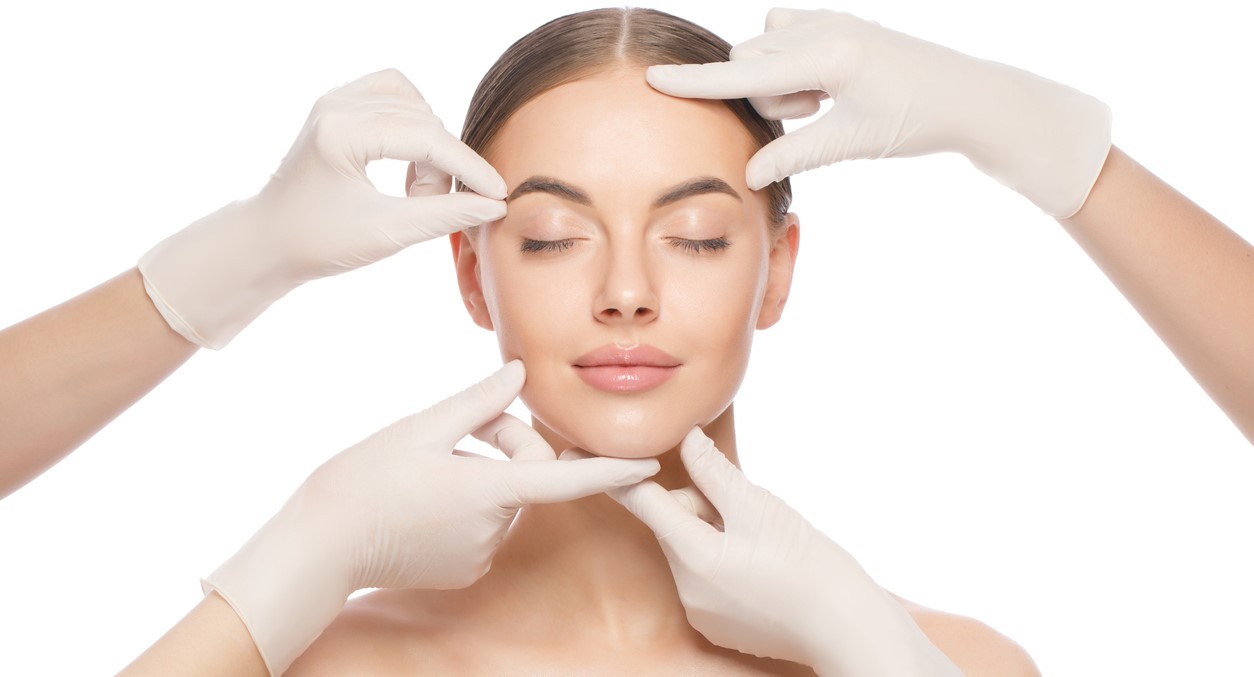The decision to get plastic surgery usually takes some time. Prospective patients need to be nurtured—they need to see services, pricing, and reputation that align with the kind of results they’re looking for. And one of the best ways to reach and nurture prospective clients is through Facebook.
There’s a reason so many plastic surgery clinics are launching Facebook Ads. With its 2.7 billion monthly active users, Facebook is a massive platform and fertile ground for building brand awareness and connecting with people throughout their decision-making journey.
Of course, there are many ways to reach more people with social media advertising, whether starting from scratch or working with existing campaigns. Here are six strategies we use to help plastic surgery groups build better campaigns on Facebook Ads.
1. Invest in Premium Ad Creative
Pick a spot in any major metropolitan area, and you’ll find a plastic surgery provider not far away. How will you compete for eyes, clicks, and conversions in such a crowded digital marketplace? You’ll need to create compelling, visually appealing ads that help prospective patients overcome their fears and apprehension—this is critical in the plastic surgery space.
Compelling Messaging
Get yourself a trusted copywriter to craft compelling headlines, ad copy, CTA language, and other copy points. This is essential to the success of your Facebook Ads. It’s best to bring your writers in early so they can collaborate with other stakeholders on the campaign, including ad specialists, social media managers, and graphic designers.
When putting together your messaging, we recommend you do a few things:
- Appeal to client motivations for getting plastic surgery, such as looking better, improving self-confidence, etc.
- Address common fears and objections head-on, including risks, outcomes, cost, timing, and so on
- Conduct interviews with past patients to understand their patient journeys
- Create detailed buyer personas that are detailed, evocative, and formalized
- Test various messaging themes to see what resonates and what doesn’t. Many clinics use Responsive Search Ads (RSAs), which allow you to load up to five variations for headline, text, and descriptions, then leave it to Facebook to serve up the best option based on performance data.

High-Quality Photos & Graphics
Ad copy and graphic design are closely intertwined. At least they should be. The graphics, photos, and other media you include in your ads should be similarly focused on the motivations, fears, and barriers to entry common to people considering plastic surgery.
When choosing imagery for your ads, keep a few things in mind:
- Always use high-quality imagery
- Keep it real (avoid stock photography)
- Use before and after photos
2. Focus Your Energy on Mobile Ads
Ninety four percent of Facebook’s total ad revenue comes from mobile ads. To reach this audience, you’ll need to do a bit more than repurpose existing desktop ads. Instead, we recommend that you build mobile-first ads from the ground up, including all requisite images, video, copy, and so on. Keep it focused on:
- Shorter pieces of content more suitable for reading on mobile devices
- Mobile-friendly images and media
- Larger font sizes for ad graphics
- Vertically oriented videos
- Mobile-optimized landing pages that are fast, and mobile responsive
3. Build Landing Pages for Each Campaign
There’s a reason we don’t recommend pointing your ads to your homepage: a good ad campaign is all about continuity. That means a consistent experience, from messaging and graphics, to the landing page itself. Otherwise, your engagement, click-through, and conversion rates will likely suffer. Instead, take the time to develop landing pages that:
- Align with your ad targeting and messaging
- Provide all of the information your target audience wants
In the world of plastic surgery, this might include an overview of a specific procedure, introductions to your surgeons, and before/after patient testimonials. Many people looking for plastic surgery are on the fence about the risks, outcomes, cost, and even publish stigma.
Finally, use a couple of strong CTAs that encourage your visitor to take the next step, such as scheduling a consultation or filling out the contact form. Again, all of this content should be optimized for the specific campaign, audience, program, and so on. For example, you might have dedicated landing pages for:
- The different types of plastic surgeries you offer (botox, liposuction, etc.)
- In-patient versus out-patient surgeries

4. Develop Good Video Content
Video content continues to sweep through the world of Facebook Ads. Facebook knows it. Just look at their tips for optimizing ad creative for mobile: most are oriented toward video ads. Video is easy for people to consume and tends to have higher engagement rates.
This is perfect for plastic surgery, where prospective patients want to see before-and-after content, hear from the surgeons, and learn more about the start-to-finish journey for a particular procedure. Of course, don’t forget patient testimonials that speak directly to people’s fears and objections about getting plastic surgery. We’ve seen plastic surgery clinics find success with user-generated video content, which is about as real as it gets.
5. Deploy a Full-funnel Strategy
Seeking plastic surgery isn’t like online shopping. The decision to modify one’s body cosmetically can take a long time. That means deploying high-value, engaging ads throughout the entire funnel—from awareness to consideration to conversion. For example:
- Show an ad to your target demographic audience (say, wealthy, middle-aged business owners)
- Use the Facebook platform to see who has engaged with the ad (analytics)
- Create a second ad campaign specifically for that engaged segment of users, with the goal of moving them toward a conversion (this might be the time for a testimonial or even an offer for a free consultation)
A simple example would be the ad that uses a video testimonial from a patient. You can configure your campaign to serve up a second ad only to those users who watched for 15 seconds or more. Ideally, this second ad builds on the first and moves that person farther along the journey toward contacting your plastic surgery group.
When you use this approach, you’re displaying ads to only the most engaged users and giving them the content that will compel them to take action. As a result, your conversion rates will go up and your acquisition costs down.
Learn more about developing a full-funnel Facebook advertising strategy that engages and converts patients.
RELATED: Are Your Facebook Ad Campaigns Ready for iOS14?
6. Test it Out and Refine
The most successful advertisers create baselines then constantly try to beat them. They don’t do so by creating a single design, tagline, or campaign and then calling it a day. Instead, test different ad variations against different audiences—constantly. This approach is essential to honing in on the ad creative that will resonate with your target audience. Try testing:
- Brand-new ad campaigns
- Changes to an existing campaign
- Brand surveys
- Common scenarios you might want to account for
You might be surprised about who is engaging with your ads and why. Do your middle-aged patients prefer before/after photos or video ads? What kind of plastic surgery services are younger demographics engaging with? Consider creating multiple variations to test different parts of your ad creative (messaging themes, keywords, etc.) and run split tests on those variations. When you do, you’ll be rewarded with better conversion rates.
7. Lastly, Do You
You might have noticed the “brand survey” option in the preceding section about testing. This is a good reminder that Facebook Ads are about more than simply driving leads. Because the journey for someone who ends up getting plastic surgery can be lengthy, branding is essential.
Think about it: the second a consumer signals to Facebook that they’re considering plastic surgery, the algorithm will start putting ads and other related content in front of them. What kind of impression will they have of your brand when they come across it? For the ads they see—especially during the consideration phase—what do you want them to remember about you (whether or not they click)?
What makes your plastic surgery group unique should extend to your Facebook Ads. It should permeate your content, imagery, messaging, and different procedures you decide to build campaigns around. In our experience working with plastic surgery centers, many people make their decision based on the connection and trust they build with a brand.
